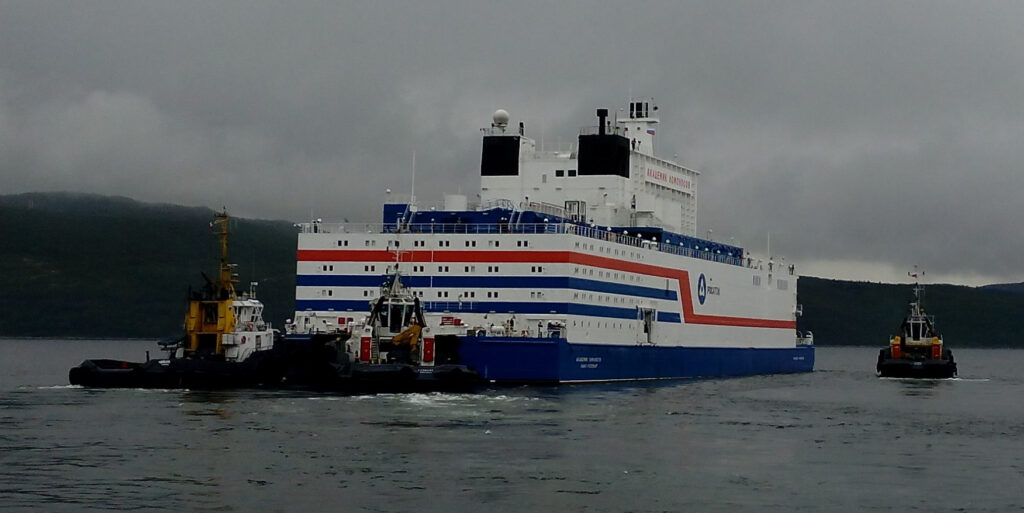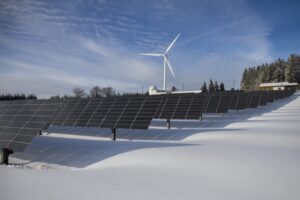- Floating Power Plants emerge as innovative alternatives in the search for sustainable and flexible energy sources, potentially redefining the global energy generation scenario.
- The strategic role of UEFs, especially nuclear and LNG, stands out in the distribution of energy in remote areas or areas with little infrastructure;
- Floating Power Plants can play a crucial role in mitigating territorial tensions, as well as strengthening the energy autonomy of nations.
As the world faces increasing challenges in the search for sustainable and flexible energy sources, Floating Power Plants (FPPs) emerge as innovative protagonists in this scenario.
Therefore, it is important to analyze the strategic and geopolitical role of FPP, analyzing their impact on global energy dynamics, in addition to the benefits and risks associated with the platforms, especially in the context of nuclear and LNG (Liquefied Natural Gas) plants.

What are Floating Power Plants
Floating Power Plants appear as innovative solutions for generating energy, located on floating structures in bodies of water. These versatile platforms house various generation technologies, such as solar, wind and even conventional plants.
Although we highlight the last two, some of the types of these floating installations are:
- Floating Solar Power Plants: in this type of power plant, solar panels are mounted on floating structures, often anchored in lakes, reservoirs or other bodies of water. This plant optimizes the water surface and improves the efficiency of the panels through the cooling provided by the water.
- Floating Wind Power Plants: these plants have their wind turbines on floating platforms in maritime environments. They are anchored on the seabed or designed to float and can take advantage of the more intense and consistent winds in deeper waters, expanding the possibilities for generating wind energy.
- Floating Nuclear Power Plants: The concept of floating nuclear power plants involves the assembly of nuclear reactors on navigable platforms, aiming to supply electricity to remote areas or areas with limited infrastructure. This mobile approach seeks flexibility in power distribution, although safety challenges and environmental impact demand attention.
- Floating LNG Plants: Floating Liquefied Natural Gas (LNG) installations stand out in the production and regasification of LNG. Floating Storage and Regasification Units (FSRUs) play a crucial role, offering flexibility in the reception, storage and processing of offshore LNG, especially in locations devoid of fixed onshore infrastructure.
In this way, the greater use of Floating Energy Platforms represents an innovative response to energy demands, maximizing the use of aquatic resources and overcoming geographical challenges.
What role can Floating Power Plants play in the energy transition?
UEFs, with an emphasis on Liquefied Natural Gas (LNG) and nuclear plants, play a crucial strategic and geopolitical role in several dimensions:
Floating Nuclear Power Plants:
- Nuclear UEFs can provide energy access in strategic areas, allowing countries to meet crucial energy needs in remote locations or in regions where terrestrial infrastructure is insufficient.
- The mobility of floating nuclear power plants makes it easier to trade energy between States and could even offer a rapid response to emergencies and humanitarian crises, providing electricity in regions affected by natural disasters or wars, for example.
- Sharing nuclear UEF technologies can be a tool to expand geopolitical influence, especially in regions where energy security is a concern.
Floating LNG Plants:
- Floating LNG FPP offer diversification in the energy matrix, reducing dependence on conventional sources and contributing to countries’ energy security.
- Strategically located, floating LNG plants facilitate international LNG trade, allowing countries to export or import natural gas more efficiently.
- The flexibility in the movement of LNG plants allows for an agile response to changes in global energy demand, allowing quick adjustments according to market conditions.
- In regions where natural gas infrastructure is limited, LNG FPP can provide a temporary or transitional solution, responding to specific energy demands.
Therefore, in both cases, UEFs, by offering flexible solutions to energy needs, have the potential to shape geopolitical dynamics, influencing relations between countries and contributing to energy security and stability on a global scale.
Countries that make use of Floating Power Plants
Several countries are already exploring the use of floating power plants. Some examples include:
- Japan: Due to its vulnerability to natural disasters such as earthquakes and tsunamis, Japan has invested in floating energy technologies, experimenting with both floating wind farms and floating solar energy projects.
- Portugal: This country was exploring offshore wind energy, including installing floating wind turbines in deep waters. This technology allows the generation of electricity in places where anchoring fixed structures would be unfeasible.
- South Korea: In addition to developing floating solar plants, South Korea was investing in offshore wind energy to harness its water resources and generate clean energy.
- Norway: This country, known for its expertise in hydroelectric power, was considering the use of floating power plants to expand its electricity generation capabilities, especially in places where building traditional dams would be challenging.
- China: China has been a pioneer in the use of floating solar plants, installing solar farms on large lakes and reservoirs. This approach makes it possible to use water areas to generate electricity, without compromising land destined for agriculture or urban development.
- Russia: Russia, through state nuclear energy company Rosatom, is boosting exports of floating nuclear power plants by signing an agreement with TSS Group to create a joint venture. This agreement aims to build floating power units for foreign markets, highlighting the versatility of these installations to meet diverse climatic conditions. The fleet, called Energoflot, will use RITM-200M reactors and targets countries in the Middle East, Southeast Asia and Africa, with operations scheduled between 2029 and 2036. The project reflects Russia’s commitment to providing stable and sustainable sources of energy , with an emphasis on energy independence and global economic development.
As an example of energy sharing between countries, we can mention Karpowership, a Turkish company, which plans to start producing 450 MW of electricity in South Africa in 2024. The South African Department of Forestry, Fisheries and Environment has given permission for a liquefied natural gas (LNG) plant in Richards Bay. South Africa granted the company access to the three ports of Ngqura, Durban and Saldanha Bay for a period of 20 years.
However, agreements with the national port company still need to be concluded, and the company seeks to sign a financial agreement by the end of 2023. Additionally, there are plans for two additional floating power plants in South Africa with a total capacity of 1.2 GW . Karpowership is in talks with other African countries to supply electricity to address the energy crisis in the region.
Türkiye’s Karpowership has the largest fleet of floating power plants in the world and supplies 100% of Guinea-Bisau’s electricity, for example. The Turkish company operates in 14 countries, mainly in Africa.
In the case of Russia, a pioneering country in the use of a Floating Nuclear Power Plant – and the only one operational in 2023 – it emerges as a notable advance in the global energy scenario, playing a strategic role of geopolitical importance and energy security.
Owned by Rosatom, the vessel known as Akademik Lomonosov, plays a key role in ensuring energy security in one of the world’s most remote and challenging regions in the Russian Arctic.
With an imposing length of 144 meters and powered by two nuclear reactors, Akademik Lomonosov not only breaks geographical boundaries, but also positions itself as the northernmost nuclear power plant in the world. This achievement not only responds to the region’s crucial energy demands, but also strengthens Russia’s energy independence, marking a strategic advance in terms of geopolitics.
However, the plant is not without controversy, with environmental groups such as Greenpeace and the Bellona Foundation raising questions about potential environmental impacts in the event of a nuclear disaster or radiation leaks if the vessel were to sink.
Despite this, Akademik Lomonosov is still a key piece in the energy geopolitics puzzle, reinforcing Russia’s position as an innovative and strategic leader in the sector.
Benefits and Risks when using Floating Power Plants
Floating Nuclear Power Plants:
Benefits:
- They enable the distribution of electricity in remote regions, boosting the development of these locations.
- The movement capacity allows an agile response to emergency situations or variations in demand, dynamically adapting to energy needs.
- They contribute to reducing emissions by replacing fossil fuel-based energy sources in places where renewable alternatives are limited.
- They face significant challenges related to public acceptance, with community resistance due to nuclear safety concerns and fears associated with proximity to nuclear facilities.
Scratchs:
- They require strict nuclear safety standards to prevent accidents, leaks or radioactive contamination, heightening concerns about safety.
- Proper management of nuclear waste is crucial, presenting significant challenges due to its radioactive nature and the need for appropriate disposal facilities.
Floating LNG Plants:
Benefits:
- They provide flexibility in the supply of LNG, allowing efficient distribution in regions with limited infrastructure.
- They speed up the international trade of natural gas, facilitating offshore regasification in strategic locations.
- They enable rapid implementation of generation capacity, responding efficiently to current demands remaining energy.
Scratchs:
- Handling LNG requires strict safety protocols, as the gas is liquefied at extremely low temperatures, posing potential risks.
- They can generate local environmental impacts, especially during regasification operations, such as changes in water temperature and potential release of chemicals.
- Despite being a cleaner transition, continued dependence on natural gas still contributes to greenhouse gas emissions, which may not be aligned with more ambitious decarbonization goals.
In both situations, getting these floating plants up and running effectively means weighing carefully about benefits and risks.
It is also essential to pay attention to problems and resolve them proactively, in addition to ensuring acceptance by the local community. This is especially crucial when it comes to nuclear power plants, given the existence of counter movements, such as the well-known “Not in My Backyard“.
What is the geopolitical importance of Floating Power Plants?
In the global scenario of energy transition, Floating Power Plants emerge as strategic pieces capable of redefining geopolitical relations.
Some countries may employ a “carrot and stick” strategy, using floating power plants as a diplomatic tool. Offering the supply of electricity from these plants can serve as an economic incentive, strengthening bilateral and regional ties, in addition to promoting development through trade agreements and assistance in the construction of infrastructure – an incentive represented by the carrot.
However, at the same time, the threat of interrupting or restricting energy supplies can be used as a diplomatic stick, pressuring other countries to adopt desired behaviors, such as complying with environmental standards or implementing specific policies. This approach seeks to balance positive incentives and punitive measures to shape the behavior of international actors in the geopolitical scenario.
Yet, these innovations not only offer flexible solutions to growing energy demands, but also play a crucial role in mitigating territorial tensions and strengthening the energy autonomy of developing nations.
By positioning these plants over bodies of water, dependence on land-based infrastructure is avoided, minimizing conflicts associated with territorial rivalries. Furthermore, the mobility of FPP, especially nuclear ones, enables rapid responses to emergencies, promoting stability in regions affected by natural disasters or humanitarian crises.
Sharing international technologies and initiatives in the field of FPP not only drives energy advances, but also becomes a soft power tool, strengthening – or creating tensions – diplomatic ties and expanding the geopolitical influence of nations that possess this technology.





Be First to Comment